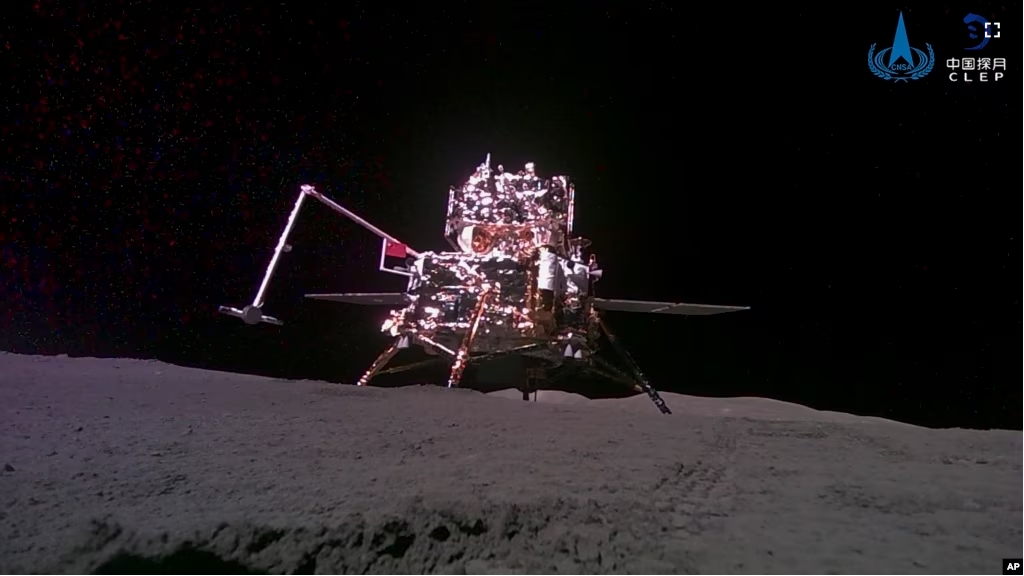Chinese space officials say a spacecraft has successfully collected samples from the moon and is headed back toward Earth.
The unmanned spacecraft, called Chang’e-6, touched down on the lunar surface on Sunday. It launched May 3 from a Chinese space center in southern China and was carried to space aboard a Long March 5 rocket.
Space officials and Chinese media said the spacecraft landed in an area of the moon’s South Pole, called the Aitken Basin. This area is known as the far side of the moon because it permanently faces away from Earth.
NASA describes the Aitken Basin as the largest impact basin on the lunar surface. The distance from the basin’s lower depths to its highest points is estimated to be over 15 kilometers. That is nearly twice the height of Earth’s tallest mountain, Mount Everest.

Controllers back on Earth then directed the space vehicle to use its drilling equipment and other tools to capture soil and rock samples. Space officials said earlier that Chang’e-6 was expected to collect up to two kilograms of soil and rock samples.
The collection operation was completed by Monday. Then on Tuesday, the spacecraft lifted off from the lunar surface carrying the samples on the trip back to Earth. The Beijing Daily newspaper reported the spacecraft displayed China’s national flag at the spot where the samples were collected.
China’s National Space Administration said in a statement that Chang’e-6’s success showed it was able to survive “the test of high temperature on the far side of the moon.”
After launching from the lunar surface, the spacecraft was to link up with another spacecraft currently orbiting the moon. The samples would then be passed to another spacecraft designed to transport the material to Earth for study. Space officials said the planned landing is expected to take place around June 25.

It is not the first time a Chinese spacecraft has collected material from the lunar surface. The country’s Chang’e 5 spacecraft traveled to the moon in late 2020. It successfully brought back about two kilograms of moon rocks and dust.
That mission was carried out in an area known as Oceanus Procellarum. It sits on the western edge of the near side of the moon. That area is believed to have had intense volcanic activity in ancient times.
But if the second Chinese collection attempt is successful, it will be the first time lunar samples from the far side of the moon have made it to Earth.
China is the third nation to successfully collect lunar samples, following the United States and the Soviet Union. The last such mission happened in 1976, when an unmanned Soviet spacecraft collected 170 grams of moon material.

America’s Apollo program – which first put humans on the moon – landed 12 astronauts over six flights from 1969 to 1972. Those missions resulted in astronauts collecting about 382 kilograms of rocks and soil.
Missions to the moon’s far side are more difficult because the area faces away from Earth. This requires the use of a special satellite to establish and keep communications. The terrain is also more difficult to explore, with fewer flat areas to land.
China has additional unmanned lunar missions planned as well. In 2026, the country’s Chang’e-7 spacecraft will aim to further explore the south polar area, including searching for water ice.
Then in 2028, Chang’e-8 will carry out a series of experiments in preparation for building a long-term science base on the moon. China has said it aims to put its astronauts on the moon by 2030.
I’m Bryan Lynn.
Bryan Lynn wrote this story for VOA Learning English, based on reports from The Associated Press and Reuters.
Quiz – Chinese Spacecraft Collects Samples from Far Side of Moon

Start the Quiz to find out
_________________________________________
Words in This Story
sample – n. a small amount of something that gives you information about the thing it was taken from
basin – n. a wide area of land that is more or less round in shape and lower than its surroundings
impact – n. the force or action of one object hitting another
drill – v. to use a tool or machine to make holes in a hard substance
terrain – n. a particular kind of land
